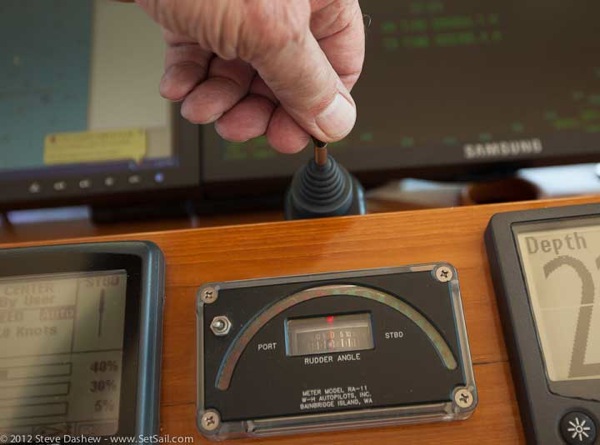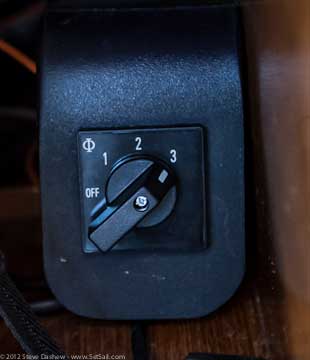
Cruising short-handed means that an easy means of steering the boat in less-than-perfect conditions is at the top of our must-haves list. This role is usually performed by the autopilot. But what happens if it fails? “We’ve got a backup pilot,” you rejoin.
OK, but are you comfortable on a long passage with only the backup? And what happens if you are struck by lightning and lose all electronics?
We’ve been thinking about these issues for many years. We actually carry several key components tucked away in the basement, totally disconnected, which means we have almost three pilots on board.
Now we think we’ve found the answer to peace of mind on this subject.
Our WH autopilots use reversing DC motors to create hydraulic power, which in turn moves the steering cylinder on the rudders. The pump is robust, the hydraulics very reliable, and none of this is subject to lightning damage. The motors which run the pumps are similarly bulletproof, and relatively immune to lightning damage. The rest of the components, however, are at risk.
The answer to the ultimate backup system, one which should work with a variety of automatic electro-mechanical steering systems, is shown above. A simple single pole, double throw, spring return switch. The switch controls heavy iron contactors, which by reversing the wiring polarity tell the motors which way to turn.
The contactors, being in essence simple magnets, should be immune from all manner of gremlins.
We started several years ago with a setup as discussed above to be wired into the system in case of an electronic component failure. We had the steering switch, connected with a long cable, to the contactors which would be wired in the engine room when required. But precise control was impossible as the motor turned too fast and the rudder speed was such that the best we could do was yaw back and forth. Better than nothing, but we were not thrilled.
Then last fall we had an idea, discussed it with Cory McMahon at Triton Marine, and set about to try a lower voltage to the pumpset motors. We had started with 24V, and by doing a tap on the battery this could be dropped to anything we liked. We tried 6V, and all of a sudden steering was much easier. Eventually this lead to a voltage selector switch.

This has three taps from the battery, and feeds the motors either 6,10, or 12 volts; rudder speed varies in concert. Given our big rudders, modest beam, and balanced lines, Wind Horse is easily steered in calm conditions with 12 volts feeding the pump motors. Offshore, on a long passage, lower voltage might work better.
At this point we have the makings of a very simple control circuit for bidirectional DC drive systems, using sets of double pole contactors to reverse the DC current direction. But our original system required us to disconnect the autopilot control circuit, lest the emergency system back-feed into it and damage components.
Which lead to another new idea. By using double pole contactors that are normally closed (when not energized) to run the day-to-day motor power, when the emergency contactor coils are energized to close the emergency steering contacts, the primary contactors are opened, and no back-feed is possible.
Cory installed the system and now we have instant direct control of the pumpset motors by moving the emergency steering lever. In other words, when we want direct control of the pilot we have it, without any electronic components.
We think this type of system will apply to a variety of other autopilots. Should you care to investigate one for yourself, here are a few items to keep in mind:
- Disconnect the main pilot system from the emergency override so as not to back-feed into it. Note that we did not use diodes for this purpose as they are vulnerable in a lightning strike.
- Experimentation with different motor speeds will be required and is most easily accomplished with a battery tap to vary voltage.
- Be sure to protect battery tap cables (and others) with fuses or breakers.
- It will make steering much easier if provisions are made for a rudder angle indicator, normally left un-wired, that can be easily turned on with a plug on each end.

March 28th, 2012 at 2:56 am
I suspect that this is a gift that a lot of people will appreciate. Nice of you to share.
March 28th, 2012 at 6:39 am
Hi Steve,
Simple and robust!
Just a great idea!
Nice to share it! Thanks!
Regards
Alain
March 28th, 2012 at 9:09 am
Steve, very innovative as usual. I will have to see how incorporate these ideas into my boat. I would like to say our Aries wind vane is our primary pilot but that just is not the case. Our Whitlock steering and special Simrad interface to it will provide some challenges. Maybe changing to hydraulic steering would make it easier to adapt your suggestions.
March 28th, 2012 at 9:55 pm
Assuming you have an electric motor that is driving a geared or belted system, what you need to do is finds its power wires. Mechanical or hydraulic – both will work.
March 29th, 2012 at 9:24 am
Steve
For those of us with hynautic (or similar) steering are we not already protected from lightning or other AP electrical gremlins?
March 31st, 2012 at 11:02 pm
Hydraulics is the driving part. You still need a means to control the solenoid valves which direct fluid flow, if the electronics quit. The key will be the speed at which the rudder turns, and whether or not this can be slowed down to an efficient speed.
April 5th, 2012 at 6:01 pm
Are there any issues running the motors at a lower voltage during a long passage?
I really like your suggestion, it reminds me of the old 12V conversion on 6V beetles.
We changed everything but the starter motor, that car would start easily after that.
April 18th, 2012 at 8:04 am
The auto pilot motors with which we are familiar run at low voltage from the start. But, DC motors generally do not care about voltage. They just turn more slowly if you reduce the volts.